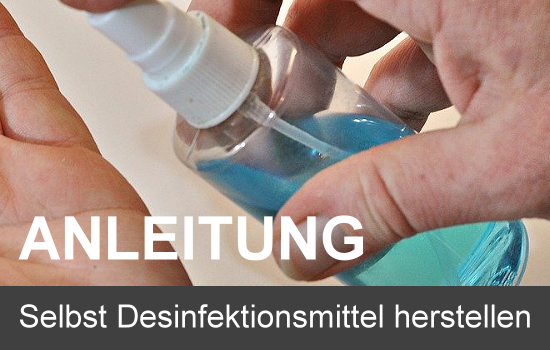Calculator make disinfectant yourself - Calculate Now
Instructions for the production of disinfectant
"I can't get no... disinfection"- this modified Mick-Jacker song could become the anthem of the current Corona epidemic, as disinfectants seem to have reached the status of a shrine everywhere. Either they are not available at all or only at extremely overpriced prices. This is particularly annoying for people who, for health reasons, are dependent on regularly disinfecting puncture sites, ports and/or medical instruments.
Disinfectant shortage
In view of the current disinfectant shortage, WHO has therefore published two recipes for the preparation of disinfectants by, for example, local pharmacies.
The following supplies are needed:
-
a sterile container (bottle, canister or similar) of the desired size (e.g. 10 liters) made of glass or plastic with a screw cap
-
either ethanol (for recipe 1) or isoproyl alcohol (for repeat 2)
-
hydrogen peroxide
-
glycerine
-
sterile water (boiled and cooled tap water or distilled water).
Furthermore, appropriate measuring containers and a funnel are required for precise dosing.
The exact mixing ratio is calculated with our online calculator based on the desired target amount of disinfectant.
How the disinfectant is produced
To ensure that the alcohol content is high enough to be antiseptic, it is recommended to check the alcohol concentration in the ethanol or isopropyl alcohol with an appropriate instrument (alcohol meter) before preparing the disinfectant solution. This is particularly important if no corresponding analysis certificate is available from the manufacturer.
First, the appropriate amount of alcohol (ethanol or isopropyl alcohol) is poured into the large bottle or canister, then the hydrogen peroxide is measured out and added, followed by the glycerin. Since glycerol is viscous, the measuring container is then rinsed with sterile water and emptied into the canister. Finally, the container is filled with the distilled or boiled water to the total amount calculated in advance. The container should be closed as quickly as possible, and the components are then thoroughly mixed together by shaking extensively.
In the final step, the solution is poured into its final containers (e.g., plastic bottles with dispensers); these should then be left for approximately 72 hours until use to ensure that any spores present in the bottles are reliably eliminated.
It is strongly recommended that no other ingredients such as fragrance or perfume be added to avoid allergic reactions.
What else should be considered when handling disinfectants?
Due to the rising vapors, the disinfectant solution should only be prepared with appropriate protective equipment, consisting of a respirator mask, protective gloves, safety goggles and protective clothing, and only by appropriately trained personnel.
The disinfectant should be stored and the dispensers located away from high temperatures or even flames. The appropriate fire regulations should be followed. In case of fire, water or AFFF foam should be used (other fire extinguishers could be counterproductive). In particular, it is important not to place dispensers near light switches, electrical outlets, or other potential sources of ignition.
Oxygen or other medical gas containers should also not be placed near disinfectants. Of course, disinfectants, residual containers and the dispensers should be placed out of the reach of children.
How do you properly disinfect your hands, especially in Corona Virus times?
Hand sanitizers are always used with dry hands, as any remaining liquid or moisture can reduce the effectiveness of the product. The hands should be rubbed until they feel dry again, the exposure time is at least 30 seconds.
When rubbing in, the thumb, fingertips and fingernails as well as the wrists should not be neglected. Long fingernails should be shortened and jewelry (watches and chains, rings, etc.) should be avoided.
Of course, you can also wash your hands with normal soap, but then use as hot water as possible and soap your hands for several minutes and several times.
Similar Calculator Topics: Health, viruses, corona, cleaning, chemistry, hygiene, diseases



